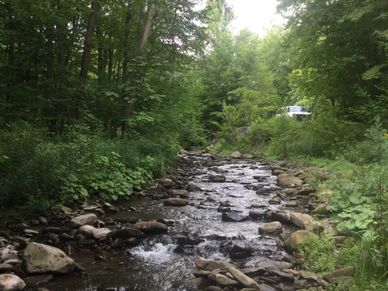Major lab projects
Evaluating the climate change resiliency in headwater streams of the upper Delaware River basin
Evaluating the climate change resiliency in headwater streams of the upper Delaware River basin

We are collaborating with the Academy of Natural Sciences of Drexel University to evaluate the resiliency of headwater streams in the upper Delaware River basin to climate change. We are evaluating both the structure and function of 50 streams with the goal of identifying factors that could potentially mitigate the effects of climate change on biodiversity and ecosystem services. This project is funded by the National Fish and Wildlife Foundation and the PA Department of Environmental Protection Growing Greener program.
Polyphosphates and phosphorus storage during phosphorus pulses
Evaluating the climate change resiliency in headwater streams of the upper Delaware River basin

Microorganisms inhabiting streams are subject to variable conditions including large swings in phosphorus concentrations driven by high concentrations associated with runoff during precipitation events and subsequently lower concentrations at low flow driven by decreased runoff and biological and non-biological uptake. Furthermore, many microorganisms have a documented mechanism for storing P as polyphosphates in excess of that needed for immediate metabolic demands. This “over- compensation” during times of excess P availability is likely common in aquatic ecosystems, especially where microbial communities are P-starved. These internal P stores allow for increased microbial metabolism and growth long after P is depleted from the external environment. Hence, rapid P fluctuations in stream ecosystems coupled with a physiological mechanism for microbial P storage suggests that P-pulses could be important drivers of microbial activity and growth in stream ecosystems. This phenomenon has many potentially important implications with regard to our understanding of how this nutrient behaves in streams and how it is managed as a pollutant by state and federal agencies.
Our project involves extensive stream sampling throughout this region and experiments in artificial stream mesocosms. Although we have accumulated a substantial dataset, we continue expand our sampling to include a greater variety of streams with varying anthropogenic impacts and exploring other potential roles that polyphosphates could play in stream ecosystems.
Algal priming of terrestrial organic matter decomposition
Algal priming of terrestrial organic matter decomposition

Stream food webs are fueled by both in-stream photosynthesis and inputs of terrestrial organic matter. While attached algae are responsible for the bulk of in-stream primary production, attached bacteria, archaea and fungi are critical decomposers of terrestrial organic matter. Although these two energy sources and the associated microbial processes have traditionally been considered distinct energetic pathways, complex microbial interactions might serve to couple these two modes of carbon delivery.